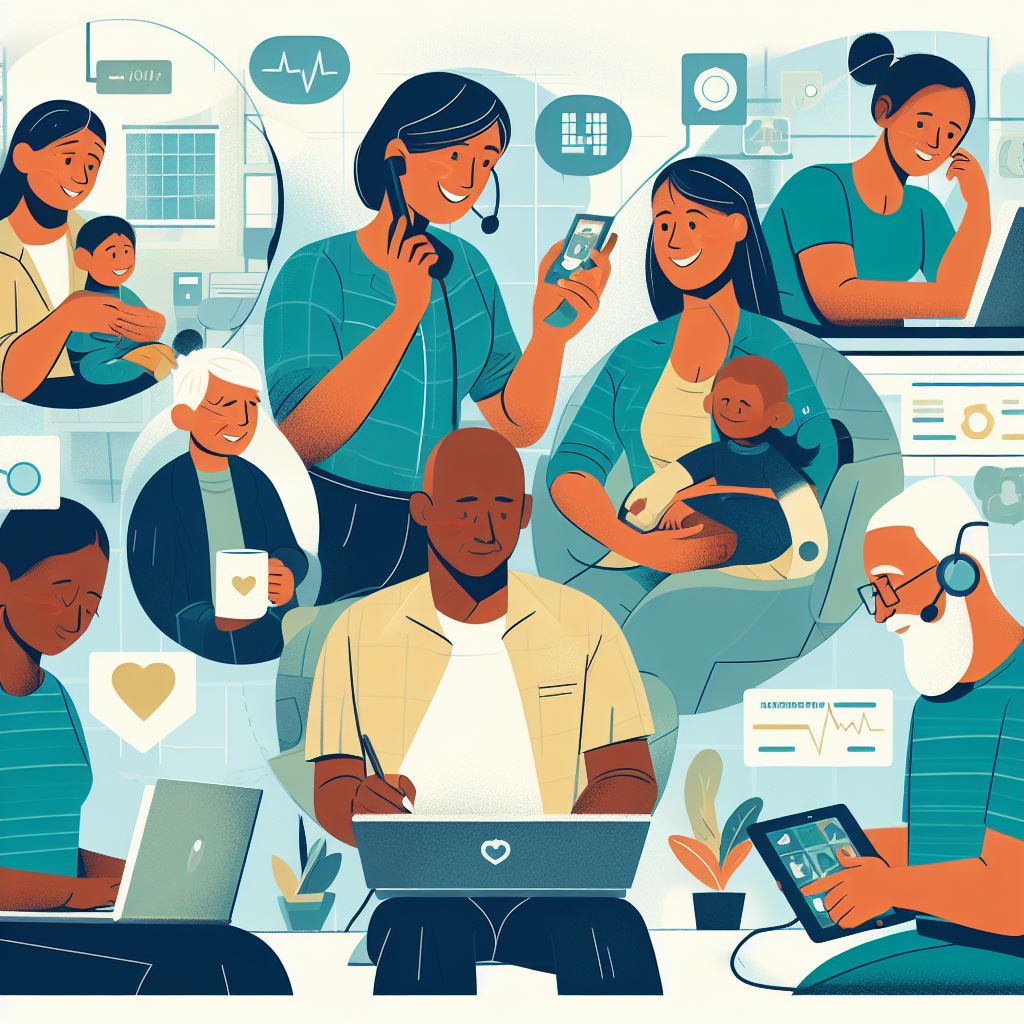4 Key Telecom Aid Programs for Low-Income Households

Are you struggling to afford essential telecommunications services? Look no further! In this article, we will explore four key telecom aid programs designed specifically for low-income households.
Imagine a single parent who needs internet access for their child’s education or a senior citizen who relies on a landline for medical emergencies. These programs, including the Lifeline Program, ConnectHome Initiative, Community Lifeline Centers, and the Emergency Broadband Benefit Program, offer crucial support to ensure that everyone has access to vital communication services.
Key Takeaways
- The Lifeline Program, established in 1985 and administered by the Universal Service Administrative Company (USAC), offers a monthly discount on phone or internet services for low-income households, with income at or below 135% of the Federal Poverty Guidelines.
- The ConnectHome Initiative, a collaborative effort between HUD, internet service providers, and local communities, aims to provide affordable internet access to low-income households in HUD-assisted housing, focusing on digital literacy training. It has expanded to over 100 communities since 2015, ensuring equal access to the benefits of the internet.
- Community Lifeline Centers provide support and resources to low-income households, offering affordable internet and phone services, training and education programs for digital literacy, and assistance with obtaining and using devices. They empower individuals to navigate the digital world.
- The Emergency Broadband Benefit Program, established by the FCC during the COVID-19 pandemic, provides financial assistance for internet services. It offers a monthly discount of up to $50 on broadband services and a one-time discount of up to $100 for devices, with an easy enrollment process. These programs bridge the digital divide, ensure access to essential communication services, facilitate staying connected with loved ones, enable access to educational resources and employment opportunities, and support telehealth services for medical emergencies.
Lifeline Program
To qualify for the Lifeline Program, you must meet certain income requirements and participate in a qualifying government assistance program. The Lifeline Program is a federal initiative that aims to provide affordable telecommunications services to low-income households. It was established in 1985 and is administered by the Universal Service Administrative Company (USAC).
The program offers a monthly discount on phone or internet services, helping eligible individuals and families stay connected in today’s digital age. In order to be eligible for the Lifeline Program, your income must be at or below 135% of the Federal Poverty Guidelines or you must participate in certain government assistance programs such as Medicaid, Supplemental Nutrition Assistance Program (SNAP), Federal Public Housing Assistance (FPHA), or the National School Lunch Program’s Free Lunch Program.
Once qualified, you can choose to apply the discount to either a home phone or a mobile phone service, or you can use it towards internet service. The Lifeline Program is crucial for low-income households as it helps bridge the digital divide and ensures that everyone has access to essential communication services. It allows individuals to stay connected with loved ones, search for employment opportunities, access educational resources, and utilize telehealth services.
With the Lifeline Program, low-income individuals and families have the opportunity to improve their quality of life and participate fully in today’s connected society. This Lifeline Program is just one of the many initiatives aimed at bridging the digital divide. Another notable program is the ConnectHome initiative, which seeks to provide affordable internet access to low-income households in HUD-assisted housing.
This initiative, along with the Lifeline Program, plays a vital role in ensuring that all individuals have equal access to the opportunities and benefits that come with being connected to the digital world.
ConnectHome Initiative
The ConnectHome Initiative aims to provide affordable internet access to low-income households in HUD-assisted housing. This program recognizes the importance of internet connectivity in today’s digital age and seeks to bridge the digital divide for those who may not have the financial means to access the internet.
Here are three key points about the ConnectHome Initiative:
- Partnership: The ConnectHome Initiative is a collaborative effort between the Department of Housing and Urban Development (HUD), internet service providers, and local communities. By partnering with these entities, the program aims to leverage existing resources and infrastructure to bring affordable internet access to eligible households.
- Digital Literacy: In addition to providing internet access, the ConnectHome Initiative also focuses on digital literacy training. Recognizing that access alone isn’t enough, the program offers resources and support to help low-income households develop the necessary skills to fully utilize the internet for educational, employment, and other opportunities.
- Expansion: Since its launch in 2015, the ConnectHome Initiative has expanded to include over 100 communities, reaching thousands of low-income households. This ongoing expansion demonstrates the program’s commitment to ensuring that all individuals, regardless of their financial circumstances, have equal access to the benefits of the internet.
Community Lifeline Centers
When accessing assistance for low-income households, it is important to consider the role of Community Lifeline Centers. These centers play a crucial role in providing support and resources to individuals and families in need. They serve as a lifeline for those who may not have access to essential services such as affordable telecommunications.
Community Lifeline Centers offer a range of services aimed at bridging the digital divide and ensuring that low-income households can stay connected. These centers not only provide access to affordable internet and phone services but also offer training and education programs to help individuals improve their digital literacy skills. By doing so, they empower low-income households to leverage the power of technology for education, employment, and accessing vital resources.
To give you a better understanding of the services offered by Community Lifeline Centers, here is a table showcasing some common offerings:
| Services | Description | Benefits |
|---|---|---|
| Affordable Internet | Low-cost internet plans for low-income households | Enables access to online resources and employment |
| Discounted Phone Plans | Reduced rates for phone services | Ensures affordable communication |
| Digital Literacy Programs | Training and education on digital skills | Empowers individuals to navigate the digital world |
| Device Assistance | Assistance in obtaining and using devices | Ensures access to technology for all |
Community Lifeline Centers play a crucial role in supporting low-income households by providing affordable telecommunications services and resources. By bridging the digital divide, these centers empower individuals and families to overcome barriers and thrive in today’s connected world.
Emergency Broadband Benefit Program
You can access the Emergency Broadband Benefit Program to receive financial assistance for your telecommunications needs. This program, established by the Federal Communications Commission (FCC), aims to help low-income households afford internet services during the ongoing COVID-19 pandemic.
Here are three key features of the program:
- Subsidized Internet Services: The Emergency Broadband Benefit Program provides a monthly discount of up to $50 on broadband services for eligible households. This discount can be applied to both fixed and mobile broadband plans, helping individuals and families stay connected to work, school, healthcare, and other essential services.
- Device Discounts: In addition to subsidizing internet services, the program also offers a one-time discount of up to $100 for the purchase of a laptop, desktop computer, or tablet from participating providers. This initiative aims to bridge the digital divide by ensuring that low-income households have access to the necessary equipment for online learning, job searching, and telehealth services.
- Easy Enrollment Process: The program’s enrollment process is designed to be simple and accessible. Eligible households can apply online, by mail, or through a participating broadband provider. The program also offers a streamlined verification process, allowing households to quickly receive the benefits they need.
Frequently Asked Questions
How Can I Apply for the Lifeline Program?
To apply for the Lifeline program, you can contact your local telecommunications provider. They will guide you through the application process and inform you of the required documents.
Are There Any Eligibility Requirements for the Connecthome Initiative?
To be eligible for the ConnectHome initiative, you must be a low-income household residing in public housing or receiving rental assistance. This program aims to bridge the digital divide and provide affordable internet access.
How Can I Find a Community Lifeline Center Near Me?
To find a community Lifeline center near you, start by researching online or contacting your local government office. They can provide you with information on the nearest centers and help you access the telecom aid programs available.
Can I Apply for Both the Lifeline Program and the Emergency Broadband Benefit Program?
Yes, you can apply for both the Lifeline program and the Emergency Broadband Benefit program. These programs provide crucial assistance to low-income households, ensuring access to essential telecommunications services. It’s a lifeline in a digital world.
What Types of Services Are Covered Under the Emergency Broadband Benefit Program?
Under the Emergency Broadband Benefit program, eligible low-income households can receive assistance for broadband services. The program covers various types of services, including internet access, equipment, and monthly service charges.



